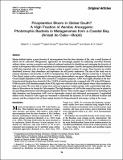Por favor, use este identificador para citar o enlazar a este item:
http://hdl.handle.net/10261/227110COMPARTIR / EXPORTAR:
 SHARE SHARE
 CORE
BASE CORE
BASE
|
|
| Visualizar otros formatos: MARC | Dublin Core | RDF | ORE | MODS | METS | DIDL | DATACITE | |

| Título: | Picoplankton Bloom in Global South? A High Fraction of Aerobic Anoxygenic Phototrophic Bacteria in Metagenomes from a Coastal Bay (Arraial do Cabo-Brazil) |
Autor: | Cuadrat, Rafael R.C.; Ferrera, Isabel CSIC ORCID; Grossart, Hans-Peter; Dávila, Alberto M.R. | Fecha de publicación: | feb-2016 | Editor: | Mary Ann Liebert | Citación: | OMICS - a Journal of Integrative Biology 20(2): 76-87 (2016) | Resumen: | Marine habitats harbor a great diversity of microorganism from the three domains of life, only a small fraction of which can be cultivated. Metagenomic approaches are increasingly popular for addressing microbial diversity without culture, serving as sensitive and relatively unbiased methods for identifying and cataloging the diversity of nucleic acid sequences derived from organisms in environmental samples. Aerobic anoxygenic phototrophic bacteria (AAP) play important roles in carbon and energy cycling in aquatic systems. In oceans, those bacteria are widely distributed; however, their abundance and importance are still poorly understood. The aim of this study was to estimate abundance and diversity of AAPs in metagenomes from an upwelling affected coastal bay in Arraial do Cabo, Brazil, using in silico screening for the anoxygenic photosynthesis core genes. Metagenomes from the Global Ocean Sample Expedition (GOS) were screened for comparative purposes. AAPs were highly abundant in the free-living bacterial fraction from Arraial do Cabo: 23.88% of total bacterial cells, compared with 15% in the GOS dataset. Of the ten most AAP abundant samples from GOS, eight were collected close to the Equator where solar irradiation is high year-round. We were able to assign most retrieved sequences to phylo-groups, with a particularly high abundance of Roseobacter in Arraial do Cabo samples. The high abundance of AAP in this tropical bay may be related to the upwelling phenomenon and subsequent picoplankton bloom. These results suggest a link between upwelling and light abundance and demonstrate AAP even in oligotrophic tropical and subtropical environments. Longitudinal studies in the Arraial do Cabo region are warranted to understand the dynamics of AAP at different locations and seasons, and the ecological role of these unique bacteria for biogeochemical and energy cycling in the ocean | Descripción: | 12 pages, 5 figures, 2 tables | Versión del editor: | https://doi.org/10.1089/omi.2015.0142 | URI: | http://hdl.handle.net/10261/227110 | DOI: | 10.1089/omi.2015.0142 | Identificadores: | issn: 1536-2310 e-issn: 1557-8100 |
| Aparece en las colecciones: | (ICM) Artículos |
Ficheros en este ítem:
| Fichero | Descripción | Tamaño | Formato | |
|---|---|---|---|---|
| Cuadrat_et_al_2016.pdf | 542,17 kB | Adobe PDF |  Visualizar/Abrir |
CORE Recommender
PubMed Central
Citations
4
checked on 25-abr-2024
SCOPUSTM
Citations
7
checked on 23-abr-2024
WEB OF SCIENCETM
Citations
7
checked on 26-feb-2024
Page view(s)
99
checked on 27-abr-2024
Download(s)
76
checked on 27-abr-2024

